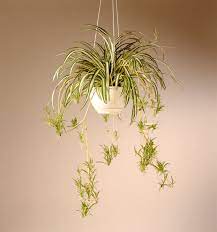Click Here to view More Content Writing Examples.
Main Keyword (in italic): care of spider plant, gardening in the spring, growing in pot
Secondary Keywords (in italic): Throughout Content.
 The Spider Plant is a fast-growing plant that produces new sub-plants at the tips of stems that arch. These stems turn into roots when they touch the soil. Amazing huh? The height of the plant is about 60cm high and 60cm spread.
The Spider Plant is a fast-growing plant that produces new sub-plants at the tips of stems that arch. These stems turn into roots when they touch the soil. Amazing huh? The height of the plant is about 60cm high and 60cm spread.
The Foliage is ribbon-like or strappy, mid-green or variegated. The climate to grow them is tropical to cool temperate. You must also use well-drained soils. The position of the Plant must be facing bright indirect light.
Are you considering starting a spring garden? Spider Plants are a part of easy spring gardening projects. We will now go through spider plant care instructions and spider plant maintenance tips.
Flowers of Spider Plant
The flowers produced by the Spider Plant are small greenish and white. It is amazing that the flower stems develop plantlets at their tips creating a beautiful drooping effect. To feed the Spider Plant you need controlled-release fertilizer inserted in the container of the plant. With watering you must create moist soil (but never wet). The Spider Plant can handle dry conditions.
Appearance of Spider Plant
Now we will talk about the appearance and characteristics of Spider Plants. In the beginning phase, the plant emerges from a root called a “Tuber”. Each Spider Plant is capable of producing multiple tubers. These Tubers spread the plant over a large area if these Tubers are not lifted/separated. Some of these Tubers can be replanted. The leaves of the Spider Plant are elongated and grass-like. The color is mid-green. Some varieties have central striping and even white margins on each blade of the leaf. These plants are some of the best plants to grow in spring.
Spider Plant Plantlets
The flowers of the Spider Plant are small and white/green in color. They grow 75cm or longer. Now this is where it gets interesting. The tip of each stem produces a small bunch of leaves (called plantlets). Then when these plantlets come into contact with the soil (or potting mix) they form roots! Then new plants form. Some people call these “Spiderettes” of the mother/main plant. You must learn how to care for spider plants indoors.
Growing Spider Plants
Most varieties of Spider Plants don’t need a lot of attention. These plants are perfect for busy couples that don’t have time to care for their garden or internal plants. For this type of plant, you can grow the pot on a table or bench. But for a more exotic look, try a hanging basket. This look means that the arching flower stems don’t touch the ground. The plantlets will hang at the ends of the stems outside the container causing a dramatic effect. You can research more spider plant maintenance tips. There are known spider plant propagation techniques. To propagate more Spider Plants cut off the plantlets and put them in an individual pot. It will even work if you put the Plantlets in a glass or bowl of water. The roots grow quite rapidly. Try not to place these plants in direct sunlight because the leaves can burn. Mainly, the Spider Plant is used as an indoor plant. It even has a reputation of improving air quality in buildings which is amazing!
Growing in Pot
You need to be aware of spider plant problems and solutions. Choose a pot that holds the weight of the root. Then you must use a premium quality potting mix that drains well because your’e going to be watering it and keeping it moist. The Spider Plant can live all of its life in the pot. How to care for spider plants indoors is important. Essentially, Spider plants are part of easy spring gardening projects. You can place the pot near a spring garden décor or a spring vegetable garden.
Garden growing
There are spider plant spring gardening tips and tricks. The Spider Plant leaves can create an attractive ground cover. The plant will spread and you can confine it with barriers. You can remove the excess plantlets around the outside and this will slow down the growth progress. In a way, you can mold the space the plant takes. This is a fun activity.
Caring for Spider Plants
You must use moist soil for Spider Plants. If you use Potting mix then it must drain well. The plant can take some periods of dryness. But if you over water the roots may rot. You must research a spider plant watering guide. For best results, you can apply controlled-release fertilizer once a year. The plant doesn’t need regular feeding so liquid fertilizers shouldn’t be needed. Best fertilizers for spider plants are needed. You must consider organic spring gardening.
Pruning Spider Plants
Our spring gardening tips and tricks include pruning a Spider Plant is fun. It all depends on the look and spread that you’re after. You can remove some of the arching stems as needed. You can also remove the plantlets to reduce overall plant size. If you keep the plantlets they will spread in autumn.
Diseases and Pests
The best thing about Spider Plants is that they have hardly any problems with diseases or pests. Sometimes you will spot that the leaf tips turn brown but this is not a disease. To fix this, pour rainwater or filtered water through the pot.
Conclusion
Spider plants are the best plants to grow in spring. As the plantlets start drooping down it has an exotic look. They are not that hard to maintain. You can create more and more if you transport the Tuber roots. Of course, if you want to learn more about planting, you may need to read our Gardening Basics and DIY Gardening for spring garden planning. Our Garden Inspiration category can assist with matching your spider plants with other plants. Our Garden structures and decor category can also give you tips on where to hang your Spider Plant. Maintaining Spider Plants and transporting the plantlets is good fun. Your visitors will love them.
Click Here to view More Content Writing Examples.

